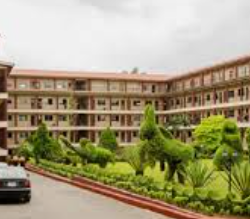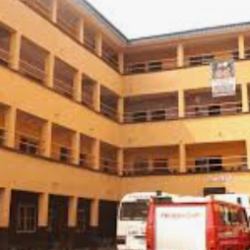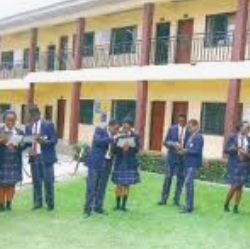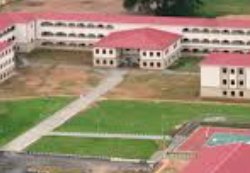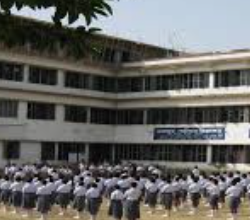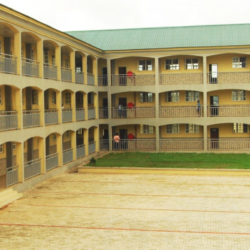Argentina’s vast size and dramatic topography give it an extraordinary range of climate zones. From lush humid forests in the north, through arid wine country and temperate plains, down to icy southern reaches and high Andean peaks, the country embodies a microcosm of climates. Below is a comprehensive look at the major climate regimes, their regional expressions, seasonal patterns, and how climate change is reshaping them.
1. Major Climate Types and Their Distribution
Broadly speaking, Argentina can be divided into four principal climate types:
- Warm / Humid Subtropical
- Moderate Humid Subtropical / Temperate
- Arid / Dry (Desert / Semi-arid)
- Cold / Cold Desert / Subantarctic / Polar
These types are determined by latitude (north to south), altitude (from lowlands to the Andes), and relief features (mountains, plains, rain shadows).
In addition, modern climate-classification systems such as Köppen split Argentina into more nuanced bands (A, B, C, D, E), where A = tropical, B = dry, C = temperate, D = continental, and E = polar climates.
Yet in practical and pedagogical terms, the four categories above capture how one often experiences weather across Argentina.
Let us explore each in turn.
2. Warm / Humid Subtropical (North)
Location & General Traits
This climate prevails in the northeast, including parts of the provinces of Misiones, Chaco, Corrientes, Formosa, and parts of northern Santa Fe. It corresponds closely with the Gran Chaco and the Upper Paraná basin.
Characteristics:
- High temperatures year-round, especially in summer.
- Substantial rainfall, often concentrated in the warmer months.
- Occurrence of thunderstorms, heavy convective rainfall, and high humidity.
- Winters are mild, though occasional cold incursions can bring cooler spells.
Example: In the city of Santiago del Estero, rainfall is low and seasonal (December–February), but summer maxima often reach 34 °C (and sometimes 40 °C).
Because this region has both heat and moisture, it is favorable for subtropical vegetation and agriculture (e.g. tobacco, citrus, sugar cane) when water is available.
Challenges in this climate include seasonal flooding, pests, pest-borne diseases (e.g. in humid summers), and variable rainfall.
3. Moderate / Temperate Humid Subtropical (Pampas & Mesopotamia Region)
Location & General Traits
This climate dominates the fertile Pampas plains, extending east from central Argentina, and also in the Mesopotamia region between the Paraná and Uruguay rivers. In these regions, summers are warm to hot and humid; winters are cooler but relatively mild.
Characteristics:
- More moderate temperature fluctuations compared to the far north.
- Rainfall more evenly distributed across the year (though summer often has more intense precipitation).
- Risk of frosts in winter.
- Occurrence of strong cold fronts bringing cooler winds (e.g. “pampero” winds sweeping across the Pampas).
The Pampas region is Argentina’s agricultural heartland. Crops such as soy, corn, wheat, and livestock grazing thrive here — provided rainfall and water conditions are favorable.
However, extremes like droughts or flooding (especially when heavy rains accompany cold fronts) are perennial hazards.
4. Arid / Dry (Desert, Semi-arid Regions)
Location & General Traits
Much of the western side of Argentina—especially in the provinces along the Andes (e.g. Mendoza, San Juan, La Rioja), parts of Patagonia, and in the “dry Pampa” west of more humid Pampas—is either arid or semi-arid.
Characteristics:
- Low annual precipitation — often concentrated in a short summer rainy season or dependent on orographic precipitation.
- Great diurnal (day/night) temperature ranges: hot days, cool nights.
- Rainfall is highly variable interannually, prone to droughts.
- Desert or steppe vegetation dominates; agriculture is feasible only with irrigation (in certain valleys).
Example: Mendoza is a classic arid zone: its climate is classified as BWk (cold desert) under Köppen. Rainfall is scarce and vineyards and orchards rely heavily on irrigation from Andean rivers.
Another example: Laguna Negra, Catamarca has a cold, arid climate with <250 mm annual precipitation.
In these zones, water management, irrigation systems, and efficient agriculture become critical.
An important local wind is the Zonda: a hot, dry, downslope wind that occurs in the Cuyo region and central Pampas. Rising on the Andes, moisture is squeezed out; on descent it becomes hot and arid. Zonda winds can reach gusts of up to 120 km/h and fuel wildfires, especially in dry seasons.
5. Cold / Subantarctic / Polar / High-Altitude Climates
Location & General Traits
Toward the far south (Patagonia, Tierra del Fuego) and in high Andean zones, Argentina enters cool, cold, or even polar-influenced climates.
Characteristics:
- Low mean annual temperatures; long cold seasons.
- In southern Patagonia and Tierra del Fuego, one finds subantarctic, cold-marine, and polar-influenced climates.
- Precipitation is often modest but can be significant in western Andean slopes (rain-shadow effects).
- Glacier and icefield systems occur in southern Andes.
- At very high elevations, alpine and cold desert climates prevail.
Example: The city of Bariloche lies in a transition zone between cool Mediterranean (Csb) and oceanic climates (Cfb), with alpine features. It experiences year-round windiness, frequent precipitation (especially in autumn–winter), and winters can bring snowfall.
In Patagonia and in the southern tip, mean annual temperatures may approach 5 °C, with significant seasonal cold and snow or ice cover.
The Perito Moreno Glacier, a famed landmark in southern Argentina, is an example of a glacier actively responding to climatic changes.
6. Seasonality & Winds: Patterns and Phenomena
Seasonal Patterns
- Summer (roughly December–February):
- Northern and central Argentina: hot, humid, and stormy.
- Western border regions: dry, with occasional convective rain in high elevations.
- Patagonia: warmer, but relatively cool; snowmelt and glacier activity.
- Winter (June–August):
- Northern zones: mild, occasional cold fronts.
- Pampas and temperate zones: cooler, frosts possible.
- Southern zones: coldest period, snow and ice.
- Andean zones: snow, blizzards at higher elevations.
- Transitional seasons (spring, autumn):
- Often unstable, with frontal systems bringing precipitation, temperature swings, and wind events.
Winds and Climatic Drivers
- Pampero Winds: Cold southern winds that sweep across the Pampas and Patagonia following the passage of a cold front. They bring relief from heat but also can cause sudden chilling.
- Sudestada: A circulation pattern along the Río de la Plata region where cold, humid southeast winds bring moisture, heavy rains, rough seas, and coastal flooding. It moderates cold but can bring storms. Occurs often from July to October.
- Zonda: As noted, a hot, dry wind descending from the Andes; in dry conditions it exacerbates fire risk, especially over central Argentina and the Cuyo region.
Topography (the long Andes chain, eastward slopes, rain shadows) plays a huge role: the Andes block moist Pacific air, creating dry leeward regions; in the west and highlands, moisture and temperature regimes depend heavily on elevation and orientation.
7. Spatial Gradients: Precipitation & Temperature
- Precipitation:
Ranges from extremely low (~150 mm/year) in parts of arid Patagonia to over 2,000 mm/year in some parts of western Patagonia and northeastern Argentina.
The coastal Andes and slopes receive orographic precipitation; interior lee sides are drier.
Rainfall tends to decline from east to west and from north to south (outside humid zones). - Temperature:
Mean annual temperatures range from about 25 °C in the far north to around 5 °C in extreme southern regions.
Day–night (diurnal) temperature swings are more pronounced in arid and high-altitude zones.
Altitude always lowers temperature: approximate lapse rates (~6 °C per 1,000 m in many Andean regions) apply.
Thus one can travel from warm sub-tropical lowlands into chilly, windy heights over the course of a day’s journey in Argentina.
8. Climate Change: Impacts & Emerging Risks
Argentina is already experiencing shifts in its climate regimes — in temperature, rainfall patterns, and the frequency of extreme events.
Observed & Projected Changes
- Rising temperatures: Night-time minima are increasing, and the number of frost days is decreasing.
- Precipitation changes: Some eastern regions have experienced higher precipitation since 1960, with greater year-to-year variability in the north.
- More intense rainfall / flooding: Recent extreme rainfall events causing floods have been linked to climate change. For example, heavy downpours in Bahía Blanca in 2025 delivered ~300 mm in just over 6 hours, triggering deadly floods. Scientists attribute part of this to added heat and moisture in the atmosphere.
- Wildfires: In Patagonia and other regions, hotter, drier winds and drought conditions are tipping the balance toward more frequent and intense wildfires.
- Agricultural stress and pests: Rising temperatures and fewer cold nights allow pests like leafhoppers (which damage corn) to proliferate beyond their traditional ranges, threatening yields.
- Glacial retreat: Iconic glaciers like Perito Moreno, once considered relatively stable, are now thinning and retreating, with ice thickness losses accelerating.
Implications & Challenges
- Water resources: In arid and semi-arid regions (already marginal), further drying or changes in snowmelt timing may strain irrigation systems.
- Agriculture: Crop zones may shift; farmers may need more resilient crop varieties or adjust sowing dates; pests could expand into new zones.
- Floods, storms, and extremes: Damage to infrastructure, urban flooding, and storm surges (especially near coasts) will require adaptation.
- Ecosystems and conservation: Ecosystems in southern and high-altitude zones (glaciers, Andean grasslands, Patagonian steppe) may face habitat shifts or species loss.
- Human settlement risk: Coastal areas, river basins, and floodplains will become more vulnerable to climate hazards.
9. Summary and Takeaways
- Argentina’s climate is extraordinarily varied, from humid subtropics in the north, through temperate agricultural zones, to arid western lands, and finally cold southern reaches and glaciated zones.
- Latitude, altitude, and relief features (especially the Andes) are the primary architects of this diversity.
- Key wind phenomena (Pampero, Sudestada, Zonda) help define regional and seasonal weather dynamics.
- Seasonal cycles follow typical southern hemisphere rhythms: warm, wet summers in many zones; cold, drier winters at higher latitudes or altitudes.
- Climate change is already altering these regimes: warming, rainfall shifts, more extremes, ecosystem stress, and glacial retreat.
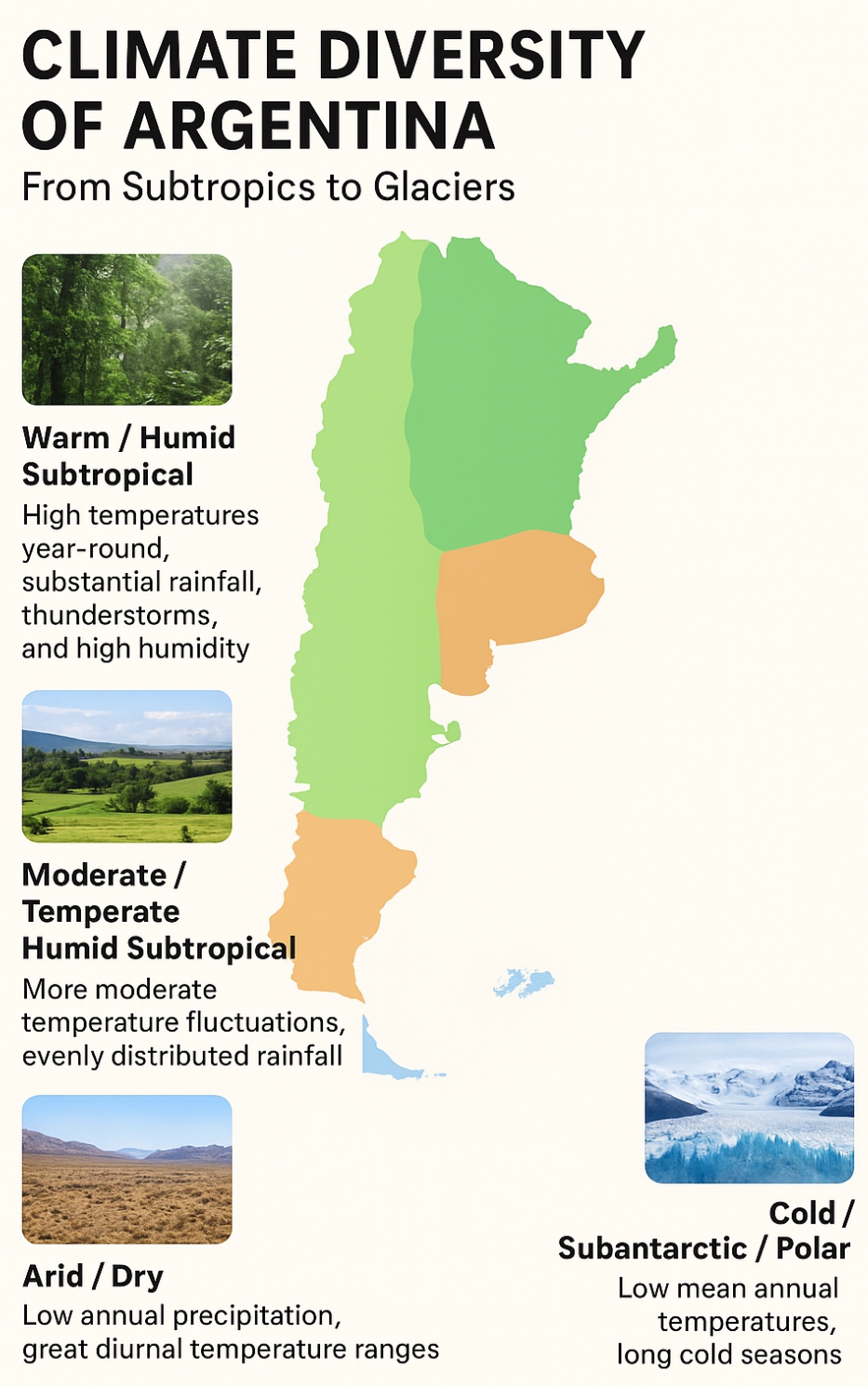
In essence, Argentina offers a tapestry of climates — making it not only geographically vast, but also climatically rich. As climate change accelerates, that diversity may become more volatile, demanding resilient planning, adaptation, and conservation across every zone.
